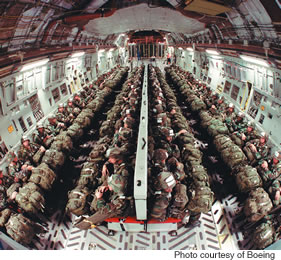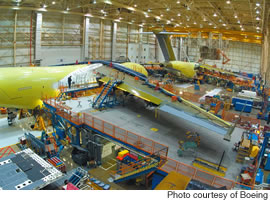A Really Big Deal
Bigger yet more agile, the Air Force’s newest transport jet, the C-17 Globemaster, now calls Hawaii home. MidWeek visited the Boeing plant where they’re made, and then enjoyed the ride home. Here’s the scoop

By .(JavaScript must be enabled to view this email address)
E-mail this story | Print this page | Archive | RSS

A C-17 takes the scenic route past Diamond Head
Some have referred to it as an SUV that handles like a sports car. It has plenty of storage space, power to get you in and out of traffic and the performance that makes an ordinary day at the office a special one.
If only Detroit could come up with something as versatile.
The C-17 Globemaster III is the newest addition to the Hawaii Air National Guard’s fleet of aircraft. At 173 feet in length and 55 feet in height, it can carry a maximum of 170,000 pounds of cargo and has a range of 5,200 nautical miles on one tank of gas. Top speed is about 500 mph, and there is room for the U.S. Army’s main battle tank, the M-1, or three Bradley infantry-fighting vehicles. The plane has rear thrusters that allow it to do things most planes cannot - back up - and the hardening of the wings and flaps with titanium allows the jets’ exhaust to be used as lift, meaning it does-n’t need a long sophisticated runway to take off.
And you thought your Hummer was an all-terrain vehicle.

The C-17 is capable of transporting up to 170,000
pounds, whether it’s 102 paratroopers or tanks
Capt. Kimo Lowe, an Air Guard pilot, says the C-17 is a big improvement over the older C-130 that he flew originally.
“It’s a great aircraft,” he says. “It’s much more capable, more payload, faster, quieter. With the C-130, half the fun of the trip was getting there. It took three days to get to Japan. In the C-17 you can get there in seven or eight hours.”
Lowe is not the only one impressed by the plane. In a 2000 article, Global Defense Review Magazine said, “The C-17 provides the U.S. Air Force with a highly reliable, multi-role aircraft with capabilities that previously were parceled out to separate airframes. In addition, Boeing is providing the life-cycle maintenance and support systems that previously were carried out by the military. This means that the Air Force gets a better plane with the added benefit of a much more affordable annual operating cost.”
Stylish, reliable and adaptable. No wonder it’s popular with consumers.

C-17s in various stages of construction at Boeing’s
Long Beach plant
The history of the C-17 goes back to the 1970s when the Air Force decided it needed a replacement for its C-130 Hercules. To answer the need, both Boeing and McDonnell Douglas proposed replacement aircraft. But not much happened until the early 1980s, when it was determined that the aging C-141 Starlifters were just not getting the job done. The aircraft was old and showing major signs of wear, plus it was not able to fulfill all the requirements set forth by the Air Force. McDonnell Douglas went ahead with its YC-15 aircraft, and that plane eventually became the C-17 after a decade of work and after Boeing had acquired its former rival.
Though Lowe would not trade the dependable old C-130 he flew in the past for the new hotrod, it will still take him some time to get used to one aspect of the new plane: having computers doing jobs that were previously reserved for humans. He says it’s a comfort level, not about feeling safer in flight.
“Right now, because I am still new to the aircraft, I wouldn’t use the word safer,” he says. “The aircraft has a lot of redundant safety features, but with the C-130 there was something reassuring with having a navigator and a flight engineer. Those positions have been removed and replaced with computers. It’s gonna take some time for me to get used to it.”
To keep proficient in the plane, pilots from Hawaii work with units at McCord Air Force Base in Washington and in Jackson, Miss. This arrangement allows Hawaii fliers to get the needed flight time while sparing their colleagues of overwork. That’s the good news. The bad
Page 1 of 2 pages for this story 1 2 >
E-mail this story | Print this page | Comments (1) | Archive | RSS
Most Recent Comment(s):
For all comments click here.









Thank you very much for the great article on the C-17 and the photos as well. The C-17 photo with Hickam’s Hale Makai Building in the foreground below the plane and Pearl Harbor in the distance background above the plane is just an incredible shot.
It brought back a lot of memories for me, because I was stationed at Hickam during 1957-1961 and I ate, slept and worked in that building. I also spent my 31 year civil service career (1966-1997) at Pearl Harbor Naval Shipyard and it’s all in that one photo. Mahalo!!
Ray N
Posted by Ray N on 03/22 at 11:24 PM